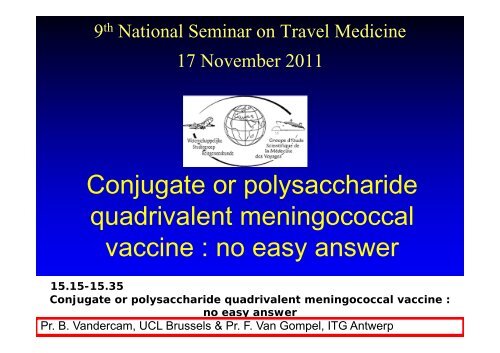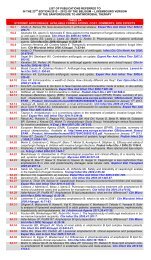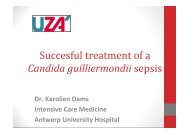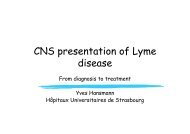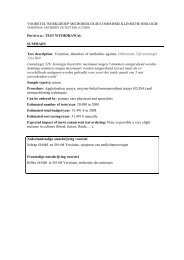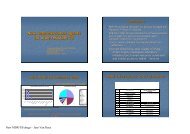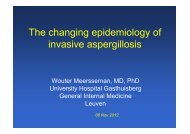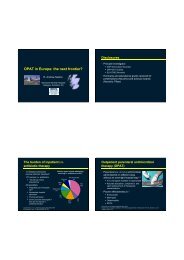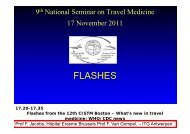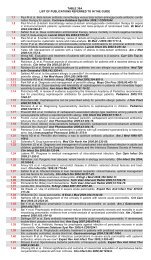Prof F. Van Gompel, ITG Antwerpen
Prof F. Van Gompel, ITG Antwerpen
Prof F. Van Gompel, ITG Antwerpen
Create successful ePaper yourself
Turn your PDF publications into a flip-book with our unique Google optimized e-Paper software.
9 th National Seminar on Travel Medicine<br />
17 November 2011<br />
Conjugate or polysaccharide<br />
quadrivalent meningococcal<br />
vaccine : no easy answer<br />
15.15-15.35<br />
Conjugate or polysaccharide quadrivalent meningococcal vaccine :<br />
no easy answer<br />
Pr. B. <strong>Van</strong>dercam, UCL Brussels & Pr. F. <strong>Van</strong> <strong>Gompel</strong>, <strong>ITG</strong> Antwerp
Conjugate or polysaccharide<br />
quadrivalent meningococcal vaccine :<br />
no easy answer ?<br />
F. <strong>Van</strong> <strong>Gompel</strong> - B. <strong>Van</strong>dercam<br />
Novembre 2011
Worldwide distribution of major meningococcal serogroups and of serogroup B<br />
outbreaks by serotype (shaded in purple). Lancet 2007, 369
Asymptomatic carriage : 10-20 %<br />
Non epidemic period, « normal » families<br />
– 18 % carriage in 32-months period<br />
– 19-38 % adult men (highest carriage)<br />
– Mean duration : 9 months (days to months)<br />
Immunologic process :<br />
– AB production within 2 weeks<br />
– Persistant > 4-6 months even with non groupable<br />
meningococci (+ cross reacting AB)<br />
– Military camps : veterans lower carriage and disease<br />
JID 1971 - J Exp Med 1969
Transmission : person to person<br />
By aerosol droplets<br />
Respiratory secretion<br />
Saliva<br />
New infection : invasive MD<br />
– Culture + : 4 days before (5/36)<br />
– Culture - : 1 day before (4/36)<br />
SHORT INCUBATION PERIOD : 1-14 DAYS<br />
NO TIME FOR NATURAL OR<br />
VACCINE BOOSTER ?
Neisseria meningitidis<br />
Risk factors for invasive disease<br />
Host factors<br />
– Terminal complement pathway deficiency (C5 – C9,<br />
properdine, facteur H ou D)<br />
– HIV infection : probably ?<br />
– Functionnal or anatomic asplenia<br />
– Genetic risk factors : polymorphisms for mannose-binding<br />
lectin and TNF<br />
Exposure factors<br />
– Household exposure<br />
– Concurrent upper respiratory tract infection<br />
– Demographic and socioeconomic factors and crowding<br />
(nightclub, alcohol, africans-americans)<br />
– Active and passive smoking<br />
– Microbiologists
Travlrs risk of MD<br />
Like general population<br />
Dormitories<br />
Educationnal or military institution<br />
Refugee camps<br />
Sporting events<br />
Discotheque<br />
School bus<br />
Risk variable<br />
Destination<br />
Mode of transport<br />
Type of accomodation<br />
Travel activities<br />
Duration of stay
Neisseria meningitidis in the US 1998-<br />
2007<br />
Older children, young adults : major cause (40 %)<br />
Absence of underlying diseases : + 50 %<br />
(other pathogens 25 – 30 %)<br />
Outbreaks : < 5 % of reported cases<br />
Case fatality rate<br />
– Pediatric 3,8 % (N = 107)<br />
– Adult 10,4 % (N = 125)<br />
Permanent sequellae : 1/5 survivors<br />
NO CHANGE IN CASE FATALITY RATE<br />
NEJM 2011, 364:2016-2025
CDC, Pink Book 2011
Annual estimated national burden of Meningococcal disease<br />
(per 100 000 population)<br />
Age group Serogroup B – C – Y N° of deaths<br />
Incidence Case fatality rate<br />
< 1 year 5,38/10 5 6 % 13/215<br />
1 year 1,47 3,4 % 2/59<br />
2-4 years 0,90 4,8 % 5/105<br />
5-13 years 0,36 10 % 14/132<br />
14-24 years 0,75 11,5 % 41/337<br />
25-64 years 0,28 12,8 % 55/429<br />
> 65 years 0,69 23,8 % 59/248<br />
CID 2010, USA
2009 = 2010 = 2011
Meningitis belt<br />
Majority serogroup A<br />
Dry season : december – june (dust wind, upper RTI)<br />
Baseline incidence 5-10-20/10 5 /year (population<br />
displacement, market, overcrowding ...)<br />
Explosive epidemics : attack rate 1000/10 5<br />
– 2009 : 78 000 cases, 4000 deaths<br />
Not a single case in travlrs (vax, social distancing)
Travlrs risk of MD<br />
1986-1989 13 cases (survey)<br />
1996-2008 11 cases (case reports)<br />
6 geosentinel<br />
0,4/10 6 /month<br />
0,5/10 5 /year<br />
Rare among travlrs<br />
Same risk industrial countries<br />
No risk O<br />
All parts of the world/all age group/all types of travelers<br />
JTM 2010, 17:9-17
JTM 2010, 17:9-17
Travlrs risk of MD<br />
Hajj pilgrims (2.10 6 )<br />
– Attack rate 640/10 5 1987 group A<br />
– Attack rate 25-30/10 5 2001 group W135<br />
– No exportation > 2004<br />
– Serogroup B in the future ?<br />
JTM 2010, 17:9-17
Travlrs risk of MD and air flight<br />
1 investigation/6 weeks CDC<br />
2 reports of inflight transmission<br />
– LA Sidney 14 h (B)<br />
– USA Frankfurt 11h (B)<br />
JTM 2010, 17:9-17
Quadrivalent polysaccharide vaccine<br />
(MPS4)<br />
50 µg of each poly-s ACYW135<br />
Dilution sterile water<br />
No preservative<br />
Subcutaneous
Quadrivalent meningococcal conjugate<br />
vaccine (MCV4)<br />
Menactra (Sanofi Pasteur) 4 µg of poly-S<br />
ACWY135<br />
+ 48 µg of diphteria toxoid (detox by formaldehyde)<br />
protein carrier<br />
Menveo (Novartis) 10 µg poly-S group A &<br />
5 µg poly-S serogroup C, Y, W135<br />
+ CRM 197 non toxic mutant of diphteria toxin<br />
No preservative, no thiomersal<br />
No adjuvant<br />
IM
Jackson PIDJ 2009
Immunogenicity of MenACWY-CRM in phase III<br />
studies in adolescents and adults<br />
Study Age<br />
group<br />
(years)<br />
Stamboulian<br />
et al<br />
(2010)<br />
19-55<br />
56-65<br />
Popula<br />
tion<br />
site<br />
2831 Men ACWY-<br />
CRM<br />
Vaccine Subjects with HSBA titers ><br />
8, 1 month post vaccination,<br />
% (95 % confidence interval)<br />
A C W-135 Y<br />
Men ACWY-<br />
CRM<br />
MPSV4<br />
81<br />
87<br />
63<br />
88<br />
90<br />
83<br />
98<br />
94<br />
95<br />
Int JID 2010<br />
88<br />
88<br />
68
% ≥1:8<br />
hSBA<br />
Persistence of Protective Immune Responses 36 months after a priming<br />
dose in Adolescence was evaluated using human complement Serum<br />
Bactericidal Assay (hSBA)<br />
*<br />
*<br />
† N=287–292; ‡ N=200–202.<br />
A<br />
*<br />
ACWY-CRM † ACWY-D ‡<br />
W-135<br />
* *<br />
Time Post Vaccination (Months)<br />
*Statistically significant difference.<br />
Jackson LA, et al. Clin Infect Dis. 2009;49:e1‐e10; Gill C, et al. Human Vaccines. 2010;6:881–887; Presented at Pediatric Academic Society (PAS) 2011;<br />
Denver, CO.<br />
*<br />
C<br />
Y<br />
* *<br />
Phase III in Adolescents<br />
Study V59P13 US
Meningococcal disease in persons<br />
vaccinated with conjugate vaccine<br />
12 reports<br />
Mean age : 18 (16 - 22)<br />
Mean time since vaccination : 3,25 year (1,5 - 4,5)<br />
Underlying condition : 5/12<br />
PS<br />
Already described with SBA satisfactory before<br />
vaccination era<br />
J Infect 1987 - JID 1981 - MMWR<br />
28 jan 2011
MMWR, aug 2011 (ACIP)
Meningococcal conjugate vaccine<br />
Significant decline in antibody 3 to 5 years after<br />
vaccination<br />
Few cases of MD among vaccinated persons<br />
Revaccination for persons at risk<br />
Vaccination with a single dose not sufficient in<br />
complement deficiency, asplenia, HIV, young<br />
children<br />
2 doses 2 months apart<br />
MMWR, jan 2011
MCV-4 booster 3 years after initial vaccination : convenience<br />
sample from MCV-4 and PSV-4 groups with vaccine-naive<br />
comparison<br />
Geometric mean serum bactericidal antibody titers<br />
Day 28<br />
Serogroup MCV-4 PSV-4<br />
A<br />
C<br />
Y<br />
W-135<br />
4326<br />
8192<br />
5846<br />
4612<br />
3270<br />
665<br />
2327<br />
1577<br />
H. Keyserling, Arch Pediatr<br />
Adolesc Med 2005 (Menactra)
MENVEO was shown to be able to be used as a<br />
booster vaccine after both Plain Polysaccharide<br />
MenACWY vaccine or a Priming Dose of MENVEO<br />
Jackson L, et al. Presented at Pediatric Academic Society (PAS) 2011; Denver, CO.<br />
Data on file. Novartis Vaccines & Diagnostics.
2009 =2010= 2011
http://www.cdc.gov/ncidod/EID/vol<br />
9no10/03-0182-G2.htm<br />
EID<br />
Volume 9,<br />
Number 10,<br />
October 2003
8. Meningococcal vaccine:<br />
Mencevax or Menveo<br />
• Since this year we have two meningococcal<br />
vaccines commercially available:<br />
– the polysaccharide vaccine Mencevax (33euro)<br />
– the new conjugated vaccine Menveo (52,6 euro).<br />
• Menveo has the advantage that<br />
– antibody titers remain longer and that immune<br />
memory is installed.<br />
– It also eradicates carriership.<br />
• It is not clear at this point at which time point<br />
a booster dose for the conjugated vaccine<br />
has to be given (3 or 5 or 10 years ?).
8. Meningococcal vaccine:<br />
Mencevax or Menveo<br />
• The risk for carriership after Hajj is very low<br />
because every pilgrim coming from endemic<br />
countries receives eradicating antibiotic treatment<br />
on arrival in Saudi Arabia. For these reasons, the<br />
consensus conference expresses no priority for<br />
either vaccine.<br />
• Mencevax® can be used when the travelers says<br />
that he only need the vaccine once (e.g; for Hajj).<br />
• Menveo® is preferred for repetitive exposition<br />
such as expats and frequent travelers to countries<br />
of the meningitis belt.<br />
• In the UK it is allowed to give Menveo from the<br />
age of 2 months
UK Green Book 2010 Chapter 22 pages 230 & 242
UK Green Book 2010 Chapter 22
Menveo ®<br />
Folia Pharmacotherapeutica maart 2011<br />
• Voor vaccinatie tegen meningokokken van de<br />
serogroepen A, C, W en Y bestaat er in België nu<br />
1. Mencevax® een polysacharidevaccin 33 euro<br />
met als voornaamste beperkingen<br />
– de geringe beschermingsduur (maximum 3 tot 5 jaar)<br />
– het beperkt immunogeen vermogen bij<br />
immuungedeprimeerde patiënten en jonge kinderen<br />
2. Menveo® een met difterie-eiwit CRM-197<br />
geconjugeerd polysacharidevaccin 52,60 Euro<br />
• De vaccinatie bestaat uit één enkele<br />
intramusculaire injectie.
Menveo ®<br />
Folia Pharmacotherapeutica mars 2011<br />
• Pour la vaccination contre les méningocoques des<br />
sérogroupes A, C, W et Y, sont disponibles en<br />
Belgique<br />
1. un vaccin polysaccharidique (Mencevax®) 33 euro<br />
dont les principales limites sont<br />
– sa durée de protection limitée (maximum 3 à 5 ans) et<br />
– son faible pouvoir immunogène chez les patients<br />
immunodéprimés et les jeunes enfants.<br />
2. Un vaccin conjugué (à la protéine CRM-197<br />
diphtérique) (Menveo®) 52,60 Euro<br />
• La vaccination consiste en une seule injection<br />
intramusculaire.
Menveo ®<br />
Folia Pharmacotherapeutica maart 2011<br />
• Uit immunologische gegevens blijkt dat het<br />
geconjugeerd vaccin Menveo®<br />
– een iets meer uitgesproken immunogeen effect tegen<br />
bepaalde meningokokkenserotypes,<br />
– een langere beschermingsduur zou hebben – maar de<br />
preciese beschermingsduur op lange termijn is echter niet<br />
bekend, gezien er geen immunogeniciteitsstudies bestaan<br />
die langer dan één jaar duren.<br />
• Voor bescherming op korte termijn (bv. bij een<br />
eenmalige reis naar een risicozone) werd geen<br />
klinische superioriteit aangetoond van het<br />
geconjugeerd vaccin tegen meningokokken A, C, W<br />
en Y, vergeleken met het polysacharidevaccin;<br />
• bij risicopatiënten die een langdurigere immuniteit<br />
wensen, kan het geconjugeerd vaccin eventueel een<br />
voordeel bieden.
Menveo ®<br />
Folia Pharmacotherapeutica mars 2011<br />
• Des données immunologiques suggèrent que, par<br />
rapport au vaccin polysaccharidique, le vaccin<br />
conjugué<br />
– serait un peu plus immunogène contre certains sérotypes<br />
de méningocoques et<br />
– qu’il confèrerait une protection plus longue – mais la durée<br />
de protection à long terme n’est cependant pas connue<br />
étant donné qu’on ne dispose pas d’étude<br />
d’immunogénicité de durée supérieure à un an.<br />
• Pour une protection à court terme (p. ex. lors d’un<br />
voyage dans une zone à risque), le vaccin conjugué<br />
contre les méningocoques A, C, W et Y n’a pas<br />
prouvé de supériorité clinique vis-à-vis du vaccin<br />
polysaccharidique;<br />
• chez les personnes à risque qui souhaitent une<br />
immunité de plus longue durée, le vaccin conjugué<br />
peut éventuellement offrir un avantage.
CDC yellow book 2012<br />
• CDC recommends routine vaccination of people with MenACWY<br />
(Menactra, Menveo) at age 11 or 12 years, with a booster dose at<br />
age 16 years.<br />
• For adolescents who receive the first dose at age 13–15 years, a<br />
one-time booster dose should be administered, preferably at age<br />
16–18 years.<br />
• People who receive their first dose of MenACWY at or after age 16<br />
years do not need a booster dose, unless they remain at<br />
continued risk for meningococcal disease.<br />
• Travelers who were vaccinated previously and are living in or<br />
returning to the meningitis belt may need to be revaccinated.<br />
• ACIP recommends that children previously vaccinated with<br />
MenACWY or MPVS4 at ages 2–6 years with a single dose who<br />
remain at an increased risk for meningococcal disease should<br />
receive an additional dose of MenACWY 3 years after their<br />
previous meningococcal vaccine and every 5 years thereafter, if at<br />
continued risk.
Belgian Scientific Study Group on<br />
Mencevax<br />
• Hadj<br />
• Single voyage<br />
Travel Medicine<br />
Menveo<br />
• Expatriates & their<br />
children<br />
• Frequent travelers<br />
• Immunodepressed<br />
• Asplenia


